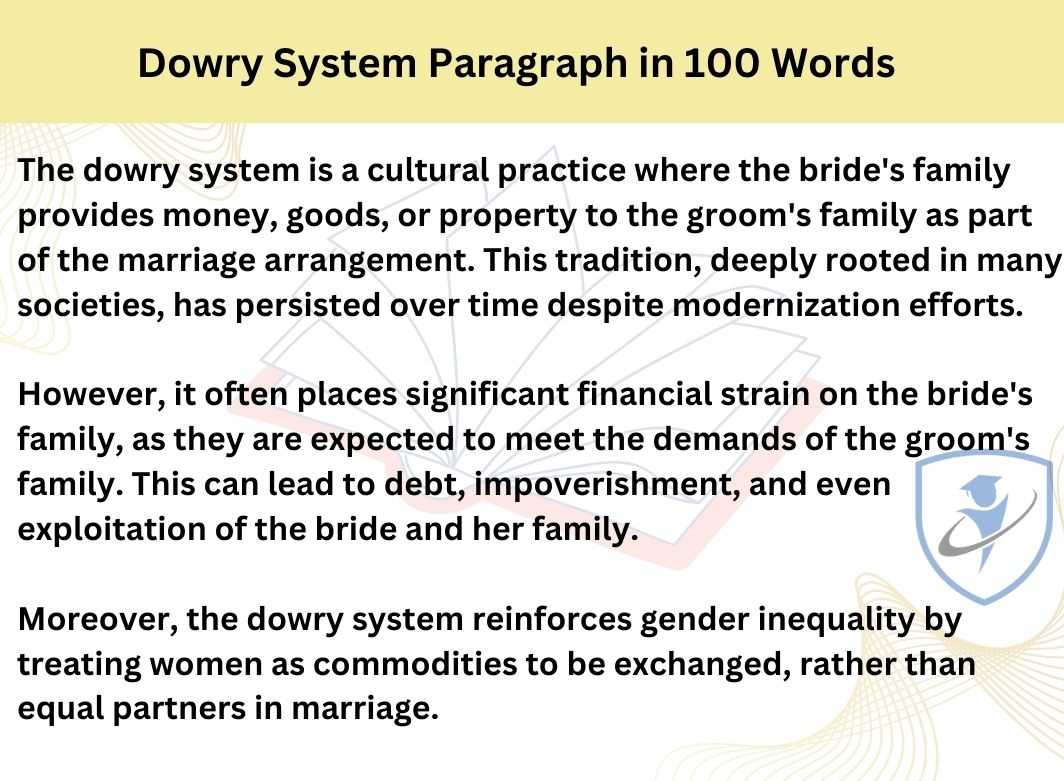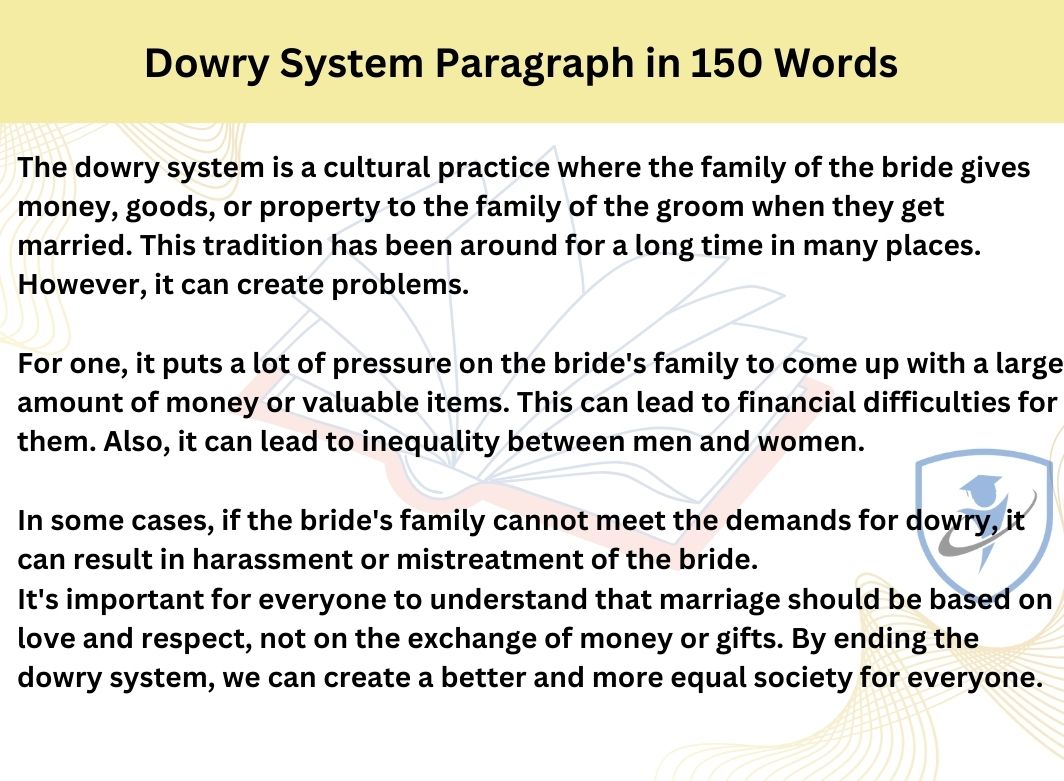Dowry System Paragraph
Dowry System Paragraph Long and Short (100- 500 words)
The dowry system, a prevalent practice in many cultures, involves the transfer of wealth from the bride’s family to the groom’s family upon marriage. Despite efforts to eradicate it, the system persists, leading to financial burdens, gender inequality, and social pressure. Addressing its root causes remains crucial for societal progress.
Dowry System Paragraph 100 Words For 1, 2, 3 Students
The dowry system is a cultural practice where the bride’s family provides money, goods, or property to the groom’s family as part of the marriage arrangement. This tradition, deeply rooted in many societies, has persisted over time despite modernization efforts.
However, it often places significant financial strain on the bride’s family, as they are expected to meet the demands of the groom’s family. This can lead to debt, impoverishment, and even exploitation of the bride and her family.
Moreover, the dowry system reinforces gender inequality by treating women as commodities to be exchanged, rather than equal partners in marriage.

Dowry System Paragraph in 150 Words For 4 & 5 Students
The dowry system is a cultural practice where the family of the bride gives money, goods, or property to the family of the groom when they get married. This tradition has been around for a long time in many places. However, it can create problems.
For one, it puts a lot of pressure on the bride’s family to come up with a large amount of money or valuable items. This can lead to financial difficulties for them. Also, it can lead to inequality between men and women.
In some cases, if the bride’s family cannot meet the demands for dowry, it can result in harassment or mistreatment of the bride.
It’s important for everyone to understand that marriage should be based on love and respect, not on the exchange of money or gifts. By ending the dowry system, we can create a better and more equal society for everyone.

Dowry System Paragraph in 200 Words For 6, 7, and 8 Students
The dowry system is a traditional practice where the bride’s family provides gifts, money, or property to the groom’s family upon marriage. While it may seem like a harmless tradition, it often leads to serious consequences.
One major issue is the financial burden it places on the bride’s family. They are expected to meet the demands of the groom’s family, which can result in debt and financial instability. Additionally, the dowry system perpetuates gender inequality by treating women as commodities to be exchanged in marriage. This can lead to exploitation and mistreatment of brides who are unable to fulfill dowry demands.
This perpetuates a cycle of dependency and reinforces traditional gender roles. Moreover, the pressure to fulfill dowry demands can lead to emotional stress and mental health issues for brides and their families.
Efforts to eradicate the dowry system are underway, but progress has been slow. It requires a collective effort from society to change deep-rooted cultural norms and beliefs. Education plays a crucial role in challenging outdated traditions and promoting gender equality. By empowering women economically and socially, we can break free from the shackles of the dowry system and build a more equitable society where marriages are based on love, respect, and mutual consent.
Dowry System Paragraph in 250 Words For 8,9,10 Students
The dowry system, a long-standing tradition in many cultures, is a practice where the bride’s family provides gifts, money, or property to the groom’s family upon marriage. While it may have originated with the intention of helping the newlyweds start their life together, it has evolved into a harmful custom with far-reaching consequences.
One of the most significant issues with the dowry system is the financial burden it imposes on the bride’s family. They are often pressured to fulfill extravagant dowry demands, leading to financial strain and sometimes even bankruptcy. This puts young women at risk of being seen as commodities to be bought and sold, rather than valued members of society.
It places greater value on sons, who are seen as sources of income through dowry, while daughters are often viewed as financial burdens. This mindset contributes to a culture where women are treated as inferior to men, both within their families and in society at large.
Families may prioritize saving for dowry over-investing in their daughters’ education, perpetuating a cycle of poverty and dependency. This not only limits women’s potential but also undermines the overall development of society.
Efforts to combat the dowry system have been ongoing, but progress has been slow. It requires a concerted effort from all members of society to challenge outdated beliefs and promote gender equality. By advocating for women’s rights and empowering them economically and socially, we can work towards a future where the dowry system is a thing of the past, and marriages are based on love, respect, and equality.
Dowry System Paragraph 300 Words For 9, 10, 11, 12 Students
The dowry system, deeply entrenched in various cultures worldwide, is a practice where the bride’s family provides gifts, money, or property to the groom’s family upon marriage. While it may have originated as a way to provide financial support to newlyweds, it has evolved into a harmful tradition with profound social and economic ramifications.
One of the primary issues stemming from the dowry system is the financial burden it places on the bride’s family. Often pressured by societal expectations and traditions, families go to great lengths to meet exorbitant dowry demands, leading to financial strain and sometimes even pushing them into debt or bankruptcy. This perpetuates a cycle of poverty and dependence, particularly for women, who are disproportionately affected by the system.
Furthermore, the dowry system reinforces gender inequality by perpetuating traditional gender roles and expectations. Sons are often valued more highly than daughters, seen as assets due to the dowry they bring, while daughters are viewed as liabilities, burdening their families with the expectation of providing dowry upon marriage. This mindset not only diminishes the worth of women but also fosters a culture of discrimination and exploitation.
Moreover, the dowry system has far-reaching implications for women’s education and employment opportunities. This not only stifles the potential of individual women but also hinders the overall progress and development of society.
Efforts to eradicate the dowry system have been ongoing for decades, yet progress remains slow and uneven. Addressing this complex issue requires a multifaceted approach, including legal reforms, educational initiatives, and community engagement.
By challenging entrenched beliefs and advocating for gender equality, we can strive towards a society where marriages are based on mutual respect and partnership, rather than material transactions. Ultimately, ending the dowry system is essential for fostering a more just and equitable world for all.
Paragraph On Dowry System in 500 Words For All Students
The dowry system, prevalent in many cultures, is a centuries-old tradition where the bride’s family gives gifts, money, or property to the groom’s family upon marriage. While it might have begun with good intentions, it has evolved into a harmful practice with significant social and economic consequences.
One of the most pressing issues with the dowry system is the financial burden it places on the bride’s family. They are often compelled to fulfill extravagant dowry demands, sometimes even taking loans or selling assets, leading to financial strain and debt. This can have long-term repercussions, pushing families into poverty and perpetuating cycles of economic instability.
Moreover, the dowry system perpetuates gender inequality by reinforcing traditional gender roles and expectations. Sons are often valued more highly than daughters because they are seen as sources of income through dowry, while daughters are considered financial liabilities. This mindset not only diminishes the worth of women but also fosters a culture where they are viewed as objects to be bought and sold, rather than equal partners in marriage.
Additionally, the dowry system has adverse effects on women’s education and employment opportunities. Families may prioritize saving for dowry over investing in their daughters’ education, perpetuating a cycle of limited opportunities and reinforcing existing disparities. This not only deprives women of their right to education but also hinders the overall progress and development of society.
Furthermore, the dowry system often leads to emotional stress and mental health issues for brides and their families. The pressure to fulfill dowry demands can create a hostile environment, leading to harassment, mistreatment, and even violence against women who are unable to meet expectations. This perpetuates a culture of fear and insecurity, where women are vulnerable to exploitation and abuse.
Efforts to eradicate the dowry system have been ongoing for decades, but progress has been slow and uneven. Legal reforms and awareness campaigns have been initiated to challenge the deep-rooted beliefs and cultural norms that sustain the practice. However, ending the dowry system requires a collective effort from all members of society, including policymakers, educators, and community leaders.
Individuals can speak out against the dowry system, advocate for women’s rights, and support organizations working to empower women economically and socially. Education and raising awareness about the harmful effects of the dowry system are also crucial steps in creating change.
Education plays a crucial role in challenging outdated traditions and promoting gender equality. By empowering women economically and socially, we can break free from the shackles of the dowry system and build a more equitable society where marriages are based on love, respect, and mutual consent.
The dowry system is a harmful practice that perpetuates gender inequality, financial instability, and emotional distress. It is essential for society to recognize the damaging effects of this tradition and work towards its eradication.
By advocating for women’s rights, promoting education, and challenging cultural norms, we can create a future where the dowry system is no longer tolerated, and marriages are founded on principles of equality and dignity for all individuals involved.
Most Important Paragraph:
| Leadership Paragraph. |
| Novel Paragraph. |
| A Memorable Day In My Life Paragraph. |
| A Book Paragraph. |
| Paragraph About Hospital. |
Frequently Asked Questions Dowry System Paragraph
Q: Why does the dowry system exist?
The dowry system originated as a way to help newlyweds start their life together by providing them with financial support. However, over time, it has evolved into a tradition with harmful consequences.
Q: What are the consequences of the dowry system?
The dowry system places a significant financial burden on the bride’s family, leading to debt and financial instability. It also perpetuates gender inequality by treating women as commodities and can result in harassment and mistreatment of brides who cannot fulfill dowry demands.
Q: Is the dowry system still prevalent today?
Yes, the dowry system is still prevalent in many cultures around the world, although its practice and intensity may vary.
Q: How does the dowry system affect women’s education and employment?
The pressure to save for dowry often leads families to prioritize financial resources for sons’ education and career prospects over daughters’. This can perpetuate cycles of poverty and limit women’s access to education and employment opportunities.
